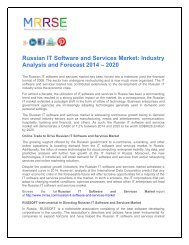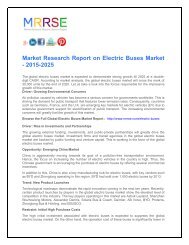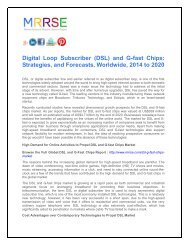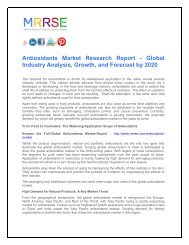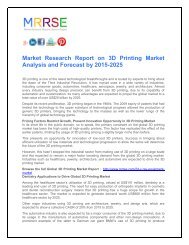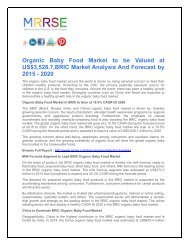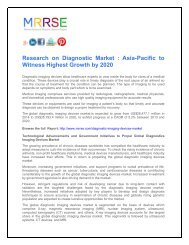Frontier Pharma : Pain Treatment Teeming Market
Create successful ePaper yourself
Turn your PDF publications into a flip-book with our unique Google optimized e-Paper software.
<strong>Frontier</strong> <strong>Pharma</strong> : <strong>Pain</strong> <strong>Treatment</strong> <strong>Teeming</strong> <strong>Market</strong><br />
Due to the diverse nature of its target, pain treatment warrants a wide range of options. The<br />
multitude of analgesics available today and the several delivery methods devised for the best<br />
patient care signify the growth and importance of the pain treatment market.<br />
<strong>Pain</strong> management and treatment deals with different levels of pain and over the years, options<br />
such as pharmacotherapy, radiation, or physical therapy, or surgery have been used to treat pain.<br />
Innovation is the key to the pain treatment market and companies have been consistently<br />
developing new and effective drugs to treat mild to severe pain.<br />
The active pipeline of pain treatment and management presently holds more than 790 products at<br />
different stages of development. Competition in the market is tough and even with the fact that the<br />
pain treatment market is considerably mature, the truth is that science and medicine can never give<br />
up on innovation. Developing new therapies that are less toxic, less addictive, and more efficacious<br />
than existing medications is the challenge that players in this market have to focus on to stay<br />
strong in the competition.<br />
The significance of first-in-class drugs for pain treatment is vital and presents increasing<br />
investment opportunities for drug manufacturing companies. The pain treatment market, in general,<br />
has witnessed a lot of activity over the past eight years, with 261 licensing deals and about 112 codevelopment<br />
deals. However, when it comes to first-in-class product deals, the market has been<br />
relatively slow.<br />
First-in-class, as the US FDA suggests, are drugs that use a novel and unique method of action to<br />
treat a medical condition. A first-in-class drug spells innovation and, though rewarding, can be<br />
extremely risky and time-consuming. However, drug companies are willing to take this risk of<br />
investment. Around 170 first-in-class products in the pain treatment market are available for codevelopment<br />
and licensing deals. Some of these products have been showcased in preclinical<br />
trials and have proven to provide high rewards for investments.<br />
Browse the full Global <strong>Pain</strong> <strong>Treatment</strong> <strong>Market</strong> report at http://www.mrrse.com/frontier-pharmapain<br />
Studies by MRRSE Research show that the market for pain treatment is dominated by steroidal<br />
anti-inflammatory drugs and opioids and the presence of novel products has been unable to<br />
challenge this dominance. In 2008, the number of patent applications for novel pain therapeutics<br />
was 4,970, which dropped to 3,492 in 2012, presenting an average annual decline of 8%. This<br />
signifies the unmet therapeutic needs when it comes to new methods of pain treatment. However,<br />
this can be addressed by technological advances and dedicated research efforts.<br />
As mentioned earlier, the active pipeline of pain treatment presently holds about 796 products at<br />
various phases of development presenting an increased diversity of molecular targets. The 122<br />
first-in-class projects in active development stage form 13.6% of the overall pipeline, of which 65<br />
first-in-class molecular targets reflect an increased level of innovation.
Big <strong>Pharma</strong> companies such as Novartis, Boehringer Ingelheim, Sanofi, Allergan, and Merck & Co.<br />
are reportedly driving the pain treatment and therapeutics market in the segment of innovation.<br />
Merck led the market between 2008 in terms of patent grants, with 59 out of 142 patent<br />
applications being granted. Boehringer Ingelheim was granted 35, Allergan received 34, while<br />
Novartis and Sanofi received 30 each.<br />
The pain treatment and management market is largely fragmented and this poses an opportunity<br />
for new classes of drugs as numerous blockbuster patents near expiration.<br />
Table of Contents<br />
1 Table of Contents<br />
1.1 List of Figures<br />
2 Executive Summary<br />
2.1 Large and Innovative Pipeline<br />
2.2 Highly Diversified Range of Innovative Programs in Early Pipeline and in Granted Patents<br />
2.3 Active Deals landscape with Numerous Investment Oppertunities<br />
3 The Case for Innovation<br />
3.1 Growing Opportunities for Biologic Products<br />
3.2 Diversification of Molecular Targets<br />
3.3 Innovative First-in-Class Product Development Remains Attractive<br />
3.4 Regulatory and Reimbursement Policy Shifts Favor First-in-Class Product Innovation<br />
3.5 Sustained Innovation<br />
3.6 MRRSE Research Report Guidance<br />
4 Clinical and Commercial Landscape<br />
4.1 Disease Overview<br />
4.1.1 Chronic and Neuropathic <strong>Pain</strong><br />
4.1.2 Disease Pathophysiology<br />
4.1.3 Diagnosis<br />
4.1.4 <strong>Treatment</strong> Option<br />
4.1.5 <strong>Treatment</strong> Algorithm
4.2 Overview of <strong>Market</strong>ed Products for <strong>Pain</strong><br />
4.2.1 Analgesic Product Categories<br />
4.2.2 Molecular Type Analysis<br />
4.2.3 Molecular Target Analysis<br />
4.2.4 Current Unmet Needs<br />
Send An Enquiry : http://www.mrrse.com/enquiry/108<br />
5 Assessment of Pipeline Product Innovation<br />
5.1 <strong>Pain</strong> Pipeline by Molecule Type, Phase and Therapeutic Targets<br />
5.2 Comparative Distribution of Programs between the <strong>Pain</strong> <strong>Market</strong> and Pipeline by Therapeutic<br />
Target Family<br />
5.3 First-in-Class Pipeline Programs<br />
5.4 First-in-Class Targets by <strong>Pain</strong> Subtype<br />
6 <strong>Pain</strong> Patent Analysis<br />
7 First-in-Class Target and Pipeline Program Evaluation<br />
7.1 Pipeline Programs Targeting Fatty Acid Amide Hydrolase<br />
7.2 Pipeline Programs Targeting Purinoceptor 3<br />
7.3 Pipeline Programs Targeting Purinoceptor 7<br />
7.4 Pipeline Programs Targeting Purinoceptor 4<br />
7.5 Pipeline Programs Targeting Orexin Receptor Type 1<br />
7.6 Pipeline Programs Targeting Neuronal Nitric Oxide Synthase<br />
7.7 Pipeline Programs that Target Tropomyosin-Related Kinase A<br />
7.8 Pipeline Programs that Target C-C Chemokine Receptor 2<br />
7.9 Pipeline Programs that Target Endomorphin 2<br />
7.10 Pipeline Programs that Target Protein Kinase C?<br />
7.11 Pipeline Programs that Target Opioid Receptor-Like-1 Receptor<br />
7.12 Pipeline Programs that Target Bradykinin B1 Receptor<br />
7.13 Pipeline Programs Targeting Galanin Receptor 2<br />
7.14 Pipeline Programs Targeting Nerve Growth Factor
8 Deals and Strategic Consolidations<br />
8.1 Industry Industry-wide First-in-Class Deals<br />
8.2 <strong>Pain</strong> Deals Landscape<br />
8.3 Licensing Deals<br />
8.3.1 Molecule Type<br />
8.3.2 Mechanism of Action<br />
8.4 Co-development Deals<br />
8.4.1 Molecule Type<br />
8.4.2 Mechanism of Action<br />
8.5 First-in-Class Programs Not Involved in Licensing or Co-Development Deals<br />
9 Appendix<br />
9.1 Abbreviations<br />
9.2 References<br />
9.3 Contact Us<br />
9.4 Disclaimer<br />
Upcoming Report :<br />
<br />
Salt <strong>Market</strong> - Global Industry Expert Opinions Analysis, Emerging Opportunities,<br />
<strong>Market</strong> Size, Share, Growth Drivers, <strong>Market</strong> Trends, Statistics And Forecast 2015 –<br />
2020 http://www.mrrse.com/salt-market<br />
Global salt production has increased in 2013 after a decline in 2011 and 2012. The rise is<br />
attributed to reviving demand from the road de-icing and chlor-alkali markets on account of<br />
economic recovery in the U.S. and Europe.<br />
Demand from the chemical sector, especially chlor-alkali and soda ash industries, is expected to<br />
drive the salt market. Additionally, winter demand from road de-icing market is another significant<br />
driver for salt market. However, salt is a volatile material and the difficulty in transportation might<br />
offset the market growth. New applications from the chemical sector are expected to bring demand<br />
prospects for salt market.
Phosphate Minerals <strong>Market</strong> - Global Industry Expert Opinions Analysis, Emerging<br />
Opportunities, <strong>Market</strong> Size, Share, Growth Drivers, <strong>Market</strong> Trends, Statistics And<br />
Forecast 2015 – 2020 http://www.mrrse.com/phosphate-minerals-market<br />
Phosphate minerals are minerals containing tetrahedrally co-ordinated anions. The phosphate<br />
group of minerals includes triphylite, monazite, pyromorphite, vanadinite, erythrite, lazulite,<br />
turquoise, autunite, carnotite apatite group, etc. Phosphate minerals of apatite group are generally<br />
mined from phosphate rocks. Main apatite mineral types include, Collophane, Francolite, and<br />
Dahlite. Other phosphate bearing minerals of economic significance are monazite, turquoise, and<br />
pyromorphite. Phosphate deposits are classified in three main types namely, marine sedimentary<br />
phosphorite, apatite-rich igneous rocks and guano accumulations. Agriculture is the largest enduser<br />
industry of phosphate minerals. Phosphate minerals are also used in food preservatives,<br />
animal feed, cosmetics, fungicides, ceramics, metallurgy and water treatment. Production of<br />
fertilizers is the major application for phosphate containing minerals. Phosphate minerals are<br />
generally mined by surface mining. After removal of ore from the ground the second stage of<br />
mining is the beneficiation process where the ore is separated by using various chemicals reagents<br />
in order to extract pure minerals.<br />
About Us<br />
<strong>Market</strong> Research Reports Search Engine (MRRSE) is an industry-leading database of market<br />
intelligence reports. Headquartered in New York, U.S., MRRSE is driven by a stellar team of<br />
research experts and advisors trained to offer objective advice. Our sophisticated search algorithm<br />
returns results based on the report title, geographical region, publisher, or other keywords.<br />
MRRSE partners exclusively with leading global publishers to provide clients single-point access to<br />
top-of-the-line market research. MRRSE’s repository is updated every day to keep its clients ahead<br />
of the next new trend in market research, be it competitive intelligence, product or service trends or<br />
strategic consulting.<br />
Contact Us:<br />
State Tower,<br />
90 State Street,<br />
Suite 700,<br />
Albany NY - 12207
United States<br />
Tel: +1-518-618-1030<br />
Email: sales@mrrse.com<br />
Website: http://www.mrrse.com/<br />
Blog: http://mrrse.blogspot.com/



